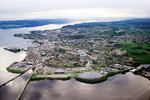NORWAY — As countries slowly begin to reopen from the novel coronavirus COVID-19 closure, many people can’t wait to come out from more than a month-long quarantine. For those like Elin …
This item is available in full to subscribers.
We have recently launched a new and improved website. To continue reading, you will need to either log into your subscriber account, or purchase a new subscription.
If you are a current print subscriber, you can set up a free website account by clicking here.
Otherwise, click here to view your options for subscribing.
Please log in to continue |
|





NORWAY — As countries slowly begin to reopen from the novel coronavirus COVID-19 closure, many people can’t wait to come out from more than a month-long quarantine. For those like Elin Flacké, 30, of Norway, who are in the high-risk category and have been in quarantine longer than her government’s 45-day mandate, there is no end in sight.
“I’ve had to accept the possibility of having to be in self-isolation for several months (until we have a vaccine and/or proper treatment for COVID-19), even if regular society starts to open up again,” Flacké said.
The Norwegian government initiated lockdown on its citizens on March 13, but Flacké and her husband had already been self-isolating because of her condition.
“I have Cystic Fibrosis (CF),” Flacké said. “It’s mainly a lung disease.”
According to the Mayo Clinic, CF affects the cells that produce mucus, sweat and digestive juices. These secreted fluids are normally thin and slippery. But in people with CF, a defective gene causes the secretions to become sticky and thick. Instead of acting as lubricants, the secretions plug up tubes, ducts and passageways, especially in the lungs and pancreas.
Flacké said her lung function is around 30 to 35 percent. Contracting COVID-19 could be deadly for her.
“I am used to being home a lot,” said Flacké, who is on disability because of her CF condition. “But for me, getting out was going to the mall once or twice a week.”
When the Norwegian government first announced its closure, Flacké felt it should have happened sooner in a city of nearly 40,000 residents.
“My husband and I saw what was happening in Italy and how it spread,” she said. “Schools and work shutdown, people are working from home. We were in a lucky position, my husband could work fully from home and I am on disability. So it hasn’t had any economic effects on us, but unemployment skyrocketed.”
While Flacké says Norway is hurting economically, she also says they are fortunate to have a good system for people who are losing their jobs.
“Most people do get something,” she said. “Many are laid off and some companies are going bankrupt.”
The country began to ease restrictions on April 27, and Flacké says since then, public places have been crowded.
“We are just now slowly starting to open society again. May 1 is a holiday here where all shops are closed and everyone has a day off,” Flacké said. “The day before, the mall was opening. It was crowded so bad.”
Getting out of the house a little before COVID-19 is different from being literally confined to her home. Flacké said she may soon start “climbing the walls.”
Kindergarten and elementary schools up to fourth and fifth grades have also opened since April 27.
“People are still socially distancing, there is a general lockdown in effect, but with the schools open, people seem to have forgotten or don’t care anymore,” she said. “I have been in self-isolation for two months. I am going crazy. We have two dogs, and they help.”
They take turns visiting with her husband’s mother, who works in the healthcare system.
“Before this corona thing all started, we were looking at moving soon to be closer to my family,” she said. “We are still looking, but have had to slow that down.”
They were still able to go to the grocery store and haven’t noticed many shortages.
“Our local grocery stores have been really good, so we haven’t been lacking anything,” she said. “I have heard the capitol stores are empty. We haven’t had too much trouble here or had a problem getting anything.”
She added that just before the shutdown, she had refilled many of her prescriptions for the coming months, and is now glad she did.
“I have all I need,” Flacké said. “It seems like the pharmacies are pretty well-stocked still.”
With restrictions easing and crowds gathering thought, Flacké doesn’t think she will be able to be social any time soon.
“I think it is important people understand, they don’t have a cure, medication, or a vaccine,” she said. “So the threat is still out there. Even though most people are still going out. Even though the majority of people don’t get that sick, the ones in the high-risk group will still be in high-risk even when society opens up again. I can take a flu shot, but there is not a COVID-19 shot, so I still have to be careful. It is important to remember, social distancing, hygiene, and handwashing.”
“But knowing I still have to be home and be careful sucks,” Flacké said. “I still think there will be a second wave. Some people are conveniently forgetting about social distancing.”